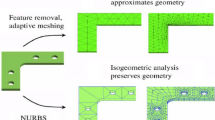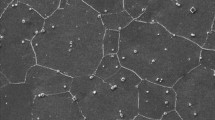Abstract
We compared the quasi-static and dynamic simulation responses on elastic-plastic deformation of advanced alloys using Finite element (FE) method with an explicit numerical algorithm. A geometrical model consisting of a cylinder-on-flat surface contact under a normal load and sliding motion was examined. Two aeroengine materials, Ti-6Al-4V and Super CMV (Cr-Mo-V) alloy, were employed in the FE analysis. The FE model was validated by comparative magnitudes of the FE-predicted maximum contact pressure variation along the contact half-width length with the theoretical Hertzian contact solution. Results show that the (compressive) displacement of the initial contact surface steadily increases for the quasi-static load case, but accumulates at an increasing rate to the maximum level for the dynamic loading. However, the relatively higher stiffness and yield strength of the Super CMV alloy resulted in limited deformation and low plastic strain when compared to the Ti-6Al-4V alloy. The accumulated equivalent plastic strain of the material point at the initial contact position was nearly a thousand times higher for the dynamic load case (for example, 6.592 for Ti-6Al-4V, 1.0 kN) when compared to the quasi-static loading (only 0.0072). During the loading step, the von Mises stress increased with a decreasing and increasing rate for the quasi-static and dynamic load case, respectively. A sudden increase in the stress magnitude to the respective peak value was registered due to the additional constraint to overcome the static friction of the mating surfaces during the sliding step.
Similar content being viewed by others
References
J. Chakrabarty, Theory of plasticity, Butterworth-Heinemann (2012).
K. L. Johnson, Contact mechanics, Cambridge University Press (1987).
A. S. Khan, Y. S. Suh and R. Kazmi, Quasi-static and dynamic loading responses and constitutive modeling of titanium alloys, International J. of Plasticity, 20 (12) (2004) 2233–2248.
A. S. Khan, M. Baig, S. H. Choi, H. S. Yang and X. Sun, Quasi-static and dynamic responses of advanced high strength steels: experiments and modeling, International J. of Plasticity, 30 (2012) 1–17.
H. Warhatkar, A. Chawla, S. Mukherjee and R. Malhotra, Experimental Study of Variation between Quasi-static and Dynamic Load Deformation Properties of Bovine Medial Collateral Ligaments, No. 2009-01-0392, SAE Technical Paper (2009).
J. Xu, Y. Li, B. Liu, M. Zhu and D. Ge, Experimental study on mechanical behavior of PVB laminated glass under quasistatic and dynamic loadings, Composites Part B: Engineering, 42 (2) (2011) 302–308.
O. S. Hopperstad, T. Børvik, M. Fourmeau, K. O. Pedersen and A. Benallal, Quasi-static and Dynamic Fracture of Highstrength Aluminium Alloy, Procedia Materials Science, 3 (2014) 51–56.
Dassault Systemes, Abaqus Theory Manual. Version 6.13. RI, USA (2013).
A. Molinari, C. Musquar and G. Sutter, Adiabatic shear banding in high speed machining of Ti-6Al-4V: experiments and modeling, International J. of Plasticity, 18 (4) (2002) 443–459.
T. J. Burns and M. A. Davies, On repeated adaiabatic shear band formation during high speed machining, International J. of Plasticity, 18 (4) (2002) 487–506.
A. Gilat and C. S. Cheng, Modeling torsional split Hopkinson bar tests at strain rates above 10,000 per sec, International Journal of Plasticity, 18 (5-6) (2002) 787–799.
A. S. Khan and O. Lopez-Pamies, Time and temperaturedependent response and relaxation of a soft polymer, International J. of Plasticity, 18 (10) (2002) 1359–1372.
A. S. Khan, O. U. Colak and P. Centala, Compressive failure strengths and modes of woven S2-glass reinforced polyester due to quasi-static and dynamic loading, International J. of Plasticity, 18 (10) (2002) 1337–1357.
T. Bjerke, Z. Li and J. Lambros, Role of plasticity in heat generation during high rate deformation and fracture of polycarbonates, International J. of Plasticity, 18 (4) (2002) 549–567.
S. Yao, L. Sun and X. Ma, Quasi-static compression of electric resistance welded mild steel tubes with axial gradientdistributed microstructures, J. of Mechanical Science and Technology, 30 (5) (2016) 1957–1965.
T. Ford, Main shafts for the Trent, Aircraft Engineering and Aerospace Technology, 69 (6) (1997) 555–560.
T. R. Hyde, Development of a representative specimen for fretting fatigue of spline joint couplings, Nottingham: University of Nottingham (2002).
A. L. Mohd Tobi, J. Ding, G. Bandak, S. B. Leen and P. H. Shipway, A study on the interaction between fretting wear and cyclic plasticity for Ti-6Al-4V, Wear, 267 (1) (2009) 270–282.
I. R. McColl, J. Ding and S. B. Leen, Finite element simulation and experimental validation of fretting wear, Wear, 256 (11) (2004) 1114–1127.
J. Elanchezhian, M. P. Kumar and G. Manimaran, Grinding titanium Ti-6Al-4V alloy with electroplated cubic boron nitride wheel under cryogenic cooling, J. of Mechanical Science and Technology, 29 (11) (2015) 4885–4890.
V. Ciampi and M. A. Crisfield, Non-linear finite element analysis of solids and structures, Meccanica, 32 (6) (1997) 586–587.
E. A. De Souza Neto, D. Peric and D. R. Owen, Computational methods for plasticity: theory and applications, Wiley (2011).
P. Wriggers and G. Zavarise, Computational contact mechanics, Encyclopedia of computational mechanics (2004).
T. A. Laursen, Computational contact and impact mechanics: fundamentals of modeling interfacial phenomena in nonlinear finite element analysis, Springer Science and Business Media (2002).
M. Benedetti and V. Fontanari, The effect of bi-modal and lamellar microstructures of Ti-6Al-4V on the behaviour of fatigue cracks emanating from edge-notches, Fatigue and Fracture of Engineering Materials and Structures, 27 (11) (2004) 1073–1089.
S. B. Leen, I. J. Richardson, I. R. McColl, E. J. Williams and T. R. Hyde, Macroscopic fretting variables in a splined coupling under combined torque and axial load, J. of Strain Analysis for Engineering Design, 36 (5) (2001) 481–497.
M. Nagentrau, W. A. Siswanto and A. L. Mohd Tobi, Investigation on the effect of linear kinematic hardening model on plasticity prediction of reciprocating sliding contact, Applied Mechanics and Materials, 773-774 (2015) 183–187.
R. Li, T. H. Hyde and W. Sun, Finite element prediction of fatigue crack growth in Super CMV hollow shafts with transverse holes under combined torsional and axial loading, J. of Strain Analysis for Engineering Design, 48 (7) (2013) 457–469.
P. A. Allen and C. D. Wilson, Hydrostatic stress effect on the yield behavior of inconel 100, J. of the Mechanical Behavior of Materials, 15 (1-2) (2004) 27–48.
Author information
Authors and Affiliations
Corresponding author
Additional information
Recommended by Associate Editor Heung Soo Kim
Waluyo Adi Siswanto is an Associate Professor in Faculty of Mechanical and Manufacturing Engineering, Universiti Tun Hussein Onn Malaysia (UTHM). His research interests are in the finite element analysis and computational mechanics.
Nagentrau Muniandy is a Research Assistant in Faculty of Mechanical and Manufacturing Engineering, Universiti Tun Hussein Onn Malaysia (UTHM). His research interests are in finite element analysis for contact problems and plastic deformation.
Abdul Latif Mohd Tobi is a Senior Lecturer in Faculty of Mechanical and Manufacturing Engineering, Universiti Tun Hussein Onn Malaysia (UTHM). His research interests are in coating fracture and wear modelling.
Mohd Nasir Tamin is a Professor in the Faculty of Mechanical Engineering, Universiti Teknologi Malaysia (UTM). His research interests are in fatigue and fracture mechanics, and computational solid mechanics.
Rights and permissions
About this article
Cite this article
Siswanto, W.A., Nagentrau, M., Mohd Tobi, A.L. et al. Prediction of plastic deformation under contact condition by quasi-static and dynamic simulations using explicit finite element analysis. J Mech Sci Technol 30, 5093–5101 (2016). https://doi.org/10.1007/s12206-016-1027-3
Received:
Revised:
Accepted:
Published:
Issue Date:
DOI: https://doi.org/10.1007/s12206-016-1027-3




